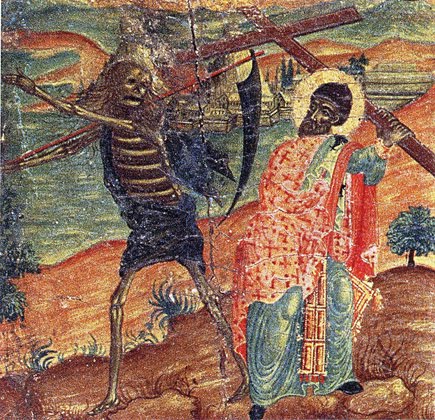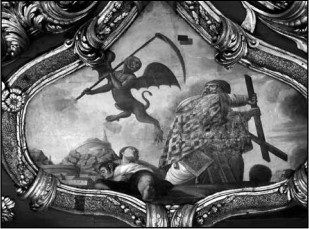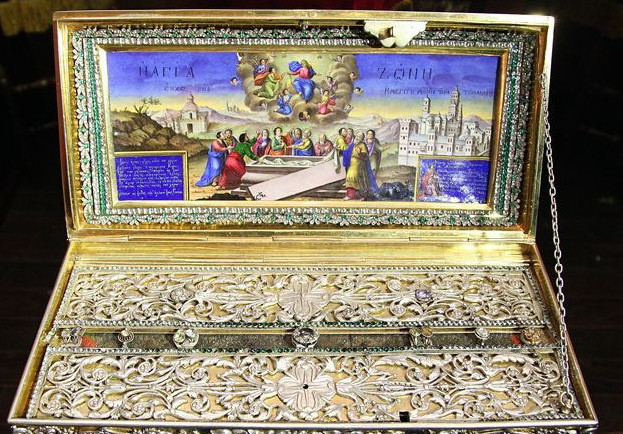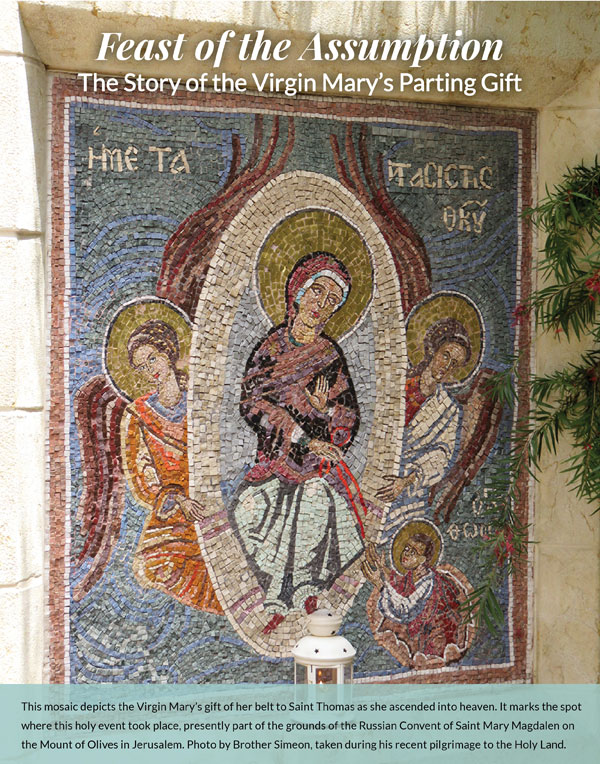Orthodox Outlet for Dogmatic Enquiries |
Historical themes |
|---|
When and how cholera and the plague were eliminated miraculously
* In Kerkyra (Corfu), 1630
* In Constantinople, 1910
|
1630: Saint Spyridon saves Corfu from the plague Source: https://www.impantokratoros.gr/A5C6DEC3.en.aspx
The witnessed vision of Saint Spyridon driving out the Plague with a Crucifix, old icon
Contrary to the recommendations of their doctors to avoid
crowding, the faithful population dared to hasten to the holy
temple of their patron Saint Spyridon in tears, and in fact
overcrowding it.... and salvation wasn’t long in arriving!
Could it be about time we did the same?
Around 1629-30 A.D. a new tribulation struck the blessed island
of Kerkyra (Corfu). It was a contagious and deadly disease,
which had now struck without discerning or mercy.
It was the plague.
Men and women, young and old, rich and poor were infected daily
by this accursed pestilence and were dying both in the city as
well as the countryside in the villages. With the onset of the
first cases, the island’s administration hastened to vote on
assigning a huge sum of money in an attempt to contain the
spread of the disease. But their struggle was in vain.
Not long after, the beautiful island of Corfu was on the brink
of becoming totally deserted. Shops both in the city as well as
the other major centres were closed.
The only things moving on the streets every now and then
were a few horse-drawn carts loaded with corpses, which took
their macabre loads outside the city for mass burials.
The island was an overall tragic picture to behold...
One day, amid this earth-shattering tragedy, and contrary to the
recommendations of their doctors to avoid crowding, the faithful
albeit suffering populace dared to
hasten en masse to the holy temple of their patron Saint
Spyridon (and in fact overcrowding it), where, with crushed
souls and burning tears they begged for his intercession. And
salvation wasn’t long in arriving. It was offered swiftly and
bounteously.
Corfu’s historian Andreas Marmoras who was alive at the time
tells us that
–despite the shortage of necessary medicines- the fearsome
epidemic very soon was confined to a minimum, and that by Palm
Sunday, it had vanished altogether.
During all of the nights that the city was being tormented by
the disease, above the roof of the Saint’s temple one could see
something that glowed like an otherworldly lamp. It was
understood as a sign that the Saint was keeping vigil and
guarding his people. This was the explanation given by all the
faithful. The glow was constantly visible by the night watchmen
standing guard atop their watchtowers.
This terrible epidemic – the plague – reappeared a
second time in Corfu, about 40 years
later,
in 1673 A.D.. Once again, the epidemic spread swiftly throughout
towns and villages. Again, the cases were more than many.
The Grim Reaper’s scythe was
once
again harvesting a very large number of the island’s
populace.
Upon the supplications of his people, the wonder-working Saint
hastened to again
deposit
their contrition and tears - along with his own - before the
throne of divine Majesty, beseeching Him and finally receiving
heavenly mercy to save them.
The words of the Spirit of God: “Call
upon Me in the day of trouble; I will deliver you, and you shall
glorify Me”
(Psalm 50:15) were truly realized in this case. To the
supplications of the divine Hierarch and the repentant people,
God’s response did not delay.
Day by day, the the spread of the disease decreased to a
minimum, and in the last days of October, they abruptly ended.
And again, above the church belfry for three nights the
people could see a steady glow, and in that otherworldly light,
the hovering form of the saint holding a Crucifix in his hand
and fending off a pitch-black ghostly form (the disease) that
was trying to avoid the Saint and escape.
The gratitude and the thanks of the faithful people were once
again immense. With an Enactment by the Venetian Administration
at the time, it was appointed that from then on, every first
Sunday of November there would be a celebratory Litany of the
Saint’s Sacred Relics throughout the land, so that the people –
and especially the younger generations – may remember the
island’s true and ever-vigilant protector and saviour.
1910: How Cholera was stopped in Constantinople Source: https://www.impantokratoros.gr/6ECB39BB.en.aspx
«In the year 1910 an accursed disease once again befell
Constantinople and its environs:
cholera. People were dying by the hundreds every day,
making it impossible to bury such large numbers – regardless of
their race and religion: Christians, Armenians, Muslims and
Jews. The population especially of Constantinople, in dread and
helplessness desperately sought its salvation.
The Temples of the Orthodox and the Armenians, the
Mosques and the Synagogues were full to bursting every day, with
their congregants begging with tears and desperation for divine
intervention to put an end to the evil.
And yet, the accursed pestilence continued its
destructive opus...
Constantinople was a horrible sight to see; all activity and
liveliness had died within it.
Then, all of a sudden the Christian population in its
state of desperation recalled the previous occurrence of 1871 in
the days of Patriarch Anthimos VI Koutalianos, and in one voice
asked that the Precious Cincture (waistband) of the Theotokos be
brought back, from its safekeeping in the Holy Mountain.
The Holy Synod convened an emergency Meeting, and with the
proposal of the blessed Patriarch Joachim III, it was decided to
dispatch a committee to the Holy Mountain, to bring back to the
City (which was paralysed by death and fear) the holiest
treasure of our piety.
Taking into account the relative Patriarchal Letters, the
Sacred Synaxis of the Holy Mountain immediately ordered two of
its most prominent Fathers to accompany the Precious Cincture to
the suffering City.
Relief and joyful shouts of hope resounded throughout the City,
when the people heard from the Patriarchy that very soon their
salvation would be arriving.
On the day of arrival of the Patriarchal representatives
together with the Hagiorite Fathers who were accompanying the
Precious Cincture, from before daybreak a host of people
regardless of their race and religion – Orthodox, Armenians,
Muslims and Jews – had already flooded the main square outside
the Railway Station of Serkitzi.
Per the scheduled time, the Ecumenical Patriarch Joachim III,
encircled by Hierarchs of the Patriarchal Court and a host of
priests, had arrived there, in order to receive the Precious
Cincture of the Theotokos, which the populace was so desperately
awaiting, to rid them of the pestilence.
The importance that both the Sultan Hamit and the Turkish
Government had acknowledged for the transportation of the
Precious Cincture was made evident by the reception that the
Turkish Government had provided, on the instruction of the
Sultan. A military
company with double rows of officers at the head had arrayed
themselves in front of the Serkitzi Station, to pay their
respects to the precious relic of Orthodoxy, whose power the
peoples of Constantinople were well familiar with, during the
year 1871.
The elderly Ecumenical Patriarch Joachim III was the first to
approach and greet the Precious Cincture.
On receiving it in his hands from the hands of the Holy
Mountain Fathers, he proceeded on foot, ahead of the Hierarchs,
the Priests, the Cantors, between the double rows of soldiers
and the Christians, Armenians, Muslims and Jews following after
them, and walked all the long road from Serkitzi Station to the
Phanar, where he deposited the sacred treasure inside the
Patriarchal temple, for veneration by the public.
Night vigils and Liturgies were served constantly; infinite
crowds flooded the Patriarchal temple every day, with tearful
supplications for their survival.
The accursed disease began to subside, its victims greatly
lessened, until – within a very few days – the City of
Constantine was completely rid of the pestilence.
The Precious Cincture was asked for by other Provinces fraught
with cholera, such as Proussa and elsewhere; upon the presence
of the holy relic, the disease disappeared, given that all the
peoples – regardless of their race and religion – had been saved
from the everyday threat of death».
|



